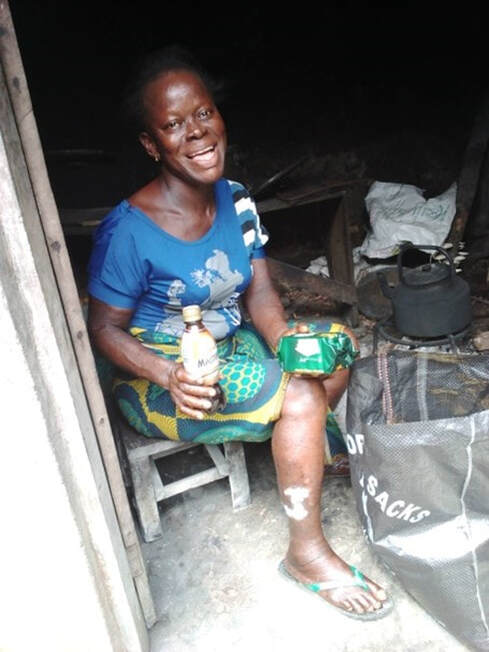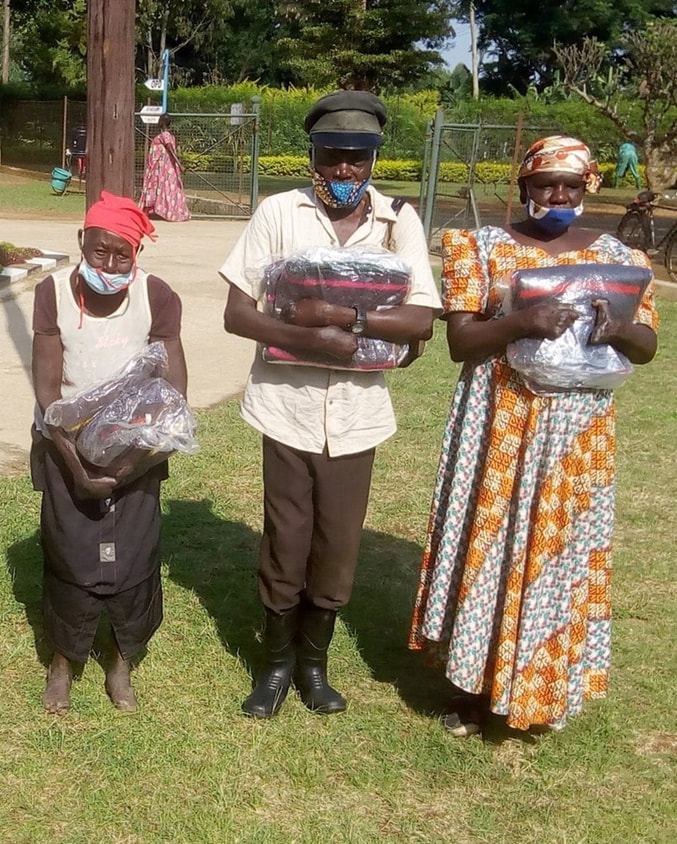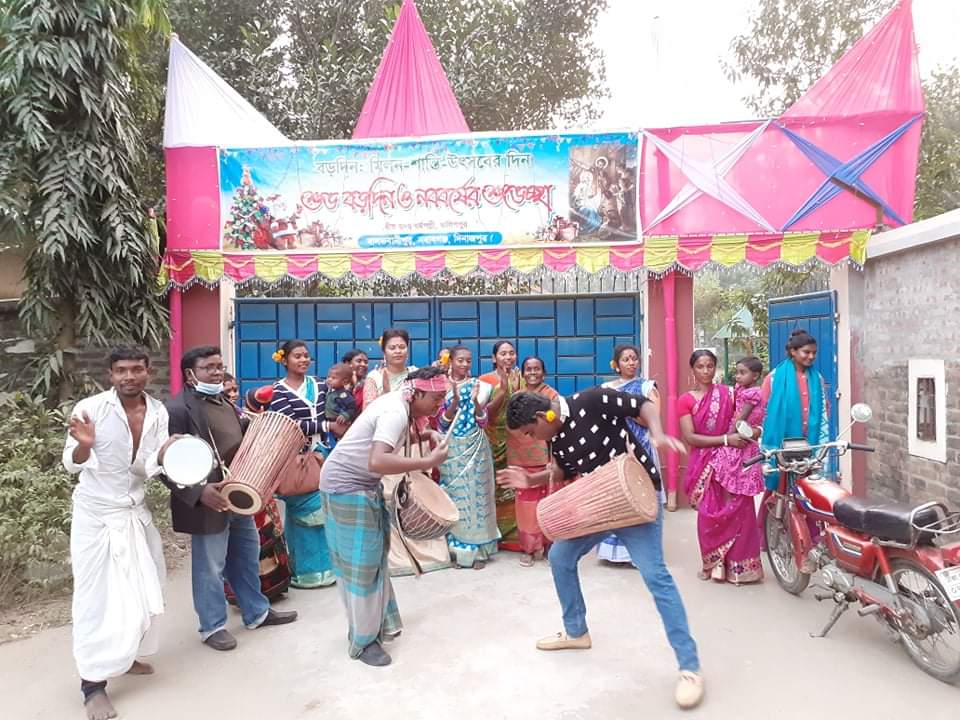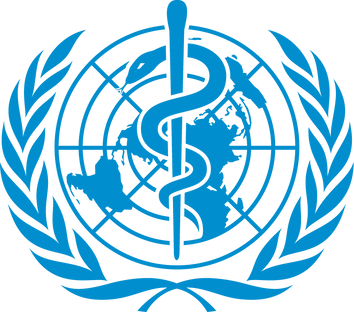CHRISTMAS UPDATE
Date: 14 December 2021
Date: 14 December 2021
SFLG launches its Christmas Appeal
“let’s make the end of leprosy the greatest gift of all”
“let’s make the end of leprosy the greatest gift of all”
London, UK, 14 December 2021: St Francis Leprosy Guild today launches its Christmas Appeal and asks it supporters to make the end of leprosy a reality.
People with leprosy are often forced to live in remote and isolated communities away from their families and friends. That means, without the support of people like our donors, there would be nothing to celebrate at Christmas time” said SFLG’s Chief Executive, Clare McIntosh.
St Francis Leprosy Guild has cared for people with leprosy for the past 125 years,” said Claire. “Today that means we work with our partners in 15 countries worldwide, to reach out to poor and remote communities and find and treat people with leprosy, before the disease takes hold.”
To make the end of leprosy a reality, we need strategies that find and treat everyone with the disease. Active case-finding is a complex combination of planning, logistics, data collection and medical skills to finds people who have leprosy, then diagnose and treat them, their families, friends, and neighbours.”
If we can find people with leprosy, village by village, town by town, city by city, and country by country, until we have found everyone who is affected, then we will start to see an end to a disease that has devastated lives since Jesus’ time.”
For the first time in centuries, an end to leprosy is within sight and SFLG is determined to play its part. But we need all the support that we can get to make the end of this disease a reality. That would be the greatest gift of all to give people with leprosy this Christmas.”

Anything that you can give will be gratefully received. Thank you.
On behalf of our Trustees, our staff, and people with leprosy worldwide, we wish you a very Merry Christmas and a Happy New Year 2022. “
Background to Active-Case Finding (“ACF”)
Until recent years, caring for people with leprosy meant providing treatment with multidrug therapy, corrective surgery to improve disabilities caused by leprosy, treatment of leprosy ulcers, and trying to reintegrate people affected by leprosy back into society when they have been shunned and ostracised.
Today, SFLG's focus is on finding, diagnosing and treating people with leprosy, as early as possible before disabilities and deformities can evolve, and the disease is passed on to others. Active Case-finding is a key component of SFLG’s TRACE strategy. Leprosy is a contagious disease, passed from person to person. It can only be fully eradicated if everyone with leprosy can be found.
SFLG works with other leprosy organisations to carry out vital community outreach work, raising awareness of the disease, monitoring for early symptoms, and overseeing treatment. This type of work is key in rural and remote communities, where people can live many miles from medical facilities and have no means of transport. As well as seeking out new cases, ACF also involves tracing the close contacts of leprosy patients, so that they can be screened for the disease, meaning the chain of infection can be broken.
Until recent years, caring for people with leprosy meant providing treatment with multidrug therapy, corrective surgery to improve disabilities caused by leprosy, treatment of leprosy ulcers, and trying to reintegrate people affected by leprosy back into society when they have been shunned and ostracised.
Today, SFLG's focus is on finding, diagnosing and treating people with leprosy, as early as possible before disabilities and deformities can evolve, and the disease is passed on to others. Active Case-finding is a key component of SFLG’s TRACE strategy. Leprosy is a contagious disease, passed from person to person. It can only be fully eradicated if everyone with leprosy can be found.
SFLG works with other leprosy organisations to carry out vital community outreach work, raising awareness of the disease, monitoring for early symptoms, and overseeing treatment. This type of work is key in rural and remote communities, where people can live many miles from medical facilities and have no means of transport. As well as seeking out new cases, ACF also involves tracing the close contacts of leprosy patients, so that they can be screened for the disease, meaning the chain of infection can be broken.
For more information please contact:
Clare McIntosh
Chief Executive Officer
St Francis Leprosy Guild
London W10 6EJ
Tel: +44 (0)7754 592240
Email: [email protected]
Twitter @StLeprosy
Facebook
Clare McIntosh
Chief Executive Officer
St Francis Leprosy Guild
London W10 6EJ
Tel: +44 (0)7754 592240
Email: [email protected]
Twitter @StLeprosy
About SFLG
St Francis Leprosy Guild (SFLG) is a UK-based, Catholic charity that is working towards a -leprosy-free world. We support the work of over 40 leprosy centres, clinics, hospitals, care homes and leprosy-related projects. We work in 15 countries worldwide in Africa, Asia and South America where leprosy is endemic. For further information please visit:
www.stfrancisleprosy.org
About leprosy
1. What is leprosy?
Leprosy (also known as Hansen’s disease) is a complex, chronic neglected tropical disease caused by the Mycobacterium leprae bacterium. It affects the skin, the upper respiratory tract and peripheral nerves in the hands and feet, and the eyes. Leprosy can affect anyone, at any age, but it is linked to poverty, malnutrition, and genetic susceptibility.
Leprosy remains a health problem in low and middle-income countries worldwide.
2. How is leprosy transmitted?
It is thought that leprosy is transmitted via droplets from the respiratory tract combined with prolonged, close contact with infected individuals.
3. How is leprosy diagnosed?
Leprosy is difficult to diagnose at its early stages, but it often presents as numb patches on the skin. Currently, the most reliable method to diagnose leprosy, is a slit-skin-smear test in the laboratory.
Leprosy may incubate for up to twenty years before presenting with any signs. If leprosy remains undiagnosed, the person affected may unwillingly transmit the disease throughout a community. However, within a short period of receiving multidrug therapy, a person affected by leprosy will no longer be infectious. If leprosy is diagnosed in its early stages, it can be treated readily, and it will not cause disabilities. Preventing disabilities from developing means people with leprosy are less likely to suffer from the stigma and discrimination that can destroy their livelihoods and entire lives.
4. How infectious is leprosy?
95% of most populations have a natural immunity to leprosy. The remaining 5% become vulnerable, mainly through poor nutrition, poor living conditions, lack of hygiene and a weakened immune system. Leprosy is not hereditary.
5. Why are people with leprosy often so disfigured?
People with leprosy lose all feeling in the affected areas and as a result, there is diminished awareness of harm from trauma or heat. Without treatment, the lack of sensation can lead to permanent damage to skin, nerves, limbs, and eyes. It can also lead to the development of reoccurring, lifelong, hard-to-treat ulcers.
6. Is there a cure? How is leprosy treated?
Leprosy can be cured using MDT, available at no cost to patients from the World Health Organization. If MDT is taken in the early stages of the disease, permanent damage to nerves is completely avoided.
7. How many are affected by leprosy in the world today?
In recent years, WHO statistics reveal that around 200,000 people are newly diagnosed with leprosy. The COVID-19 pandemic has had a significant impact on health services and leprosy programmes have been affected with a wide disruption to services in many countries. Of great concern is that people with leprosy may receive a late diagnosis and develop lifechanging, visible disabilities as a result. The next WHO WER which will be issued in September 2022, may reveal the hidden truth.
These statistics do not account for those people who have leprosy with no symptoms or, who are not diagnosed and are unwittingly transmitting it to their communities. In addition, the statistics do not include those individuals who have been treated for leprosy, but whose disabilities, caused by leprosy need ongoing healthcare needs, or those who are subject to leprosy stigma and discrimination.
8. Which countries have leprosy, where is leprosy endemic?
127 countries worldwide reported leprosy to the WHO during 2021. *The WHO has identified 23 global priority countries for leprosy, where over 95% of the global total of people detected with leprosy are found. The 23 countries are: Angola, Bangladesh, Brazil, Comoros, Cote Ivoire, DR Congo, Egypt, Ethiopia, India, Indonesia, Kiribati, Madagascar, Micronesia, Mozambique, Myanmar, Nepal, Nigeria, Philippines, South Sudan, Sri Lanka, Sudan, Somalia, and Tanzania.
Brazil, Indonesia and India between them account for nearly 80% of people with leprosy.
*WHO Weekly epidemiological record, Global Leprosy Update 10 September 2021, 36, 2021, 96, 421-444 http://www.who.int/wer
St Francis Leprosy Guild (SFLG) is a UK-based, Catholic charity that is working towards a -leprosy-free world. We support the work of over 40 leprosy centres, clinics, hospitals, care homes and leprosy-related projects. We work in 15 countries worldwide in Africa, Asia and South America where leprosy is endemic. For further information please visit:
www.stfrancisleprosy.org
About leprosy
1. What is leprosy?
Leprosy (also known as Hansen’s disease) is a complex, chronic neglected tropical disease caused by the Mycobacterium leprae bacterium. It affects the skin, the upper respiratory tract and peripheral nerves in the hands and feet, and the eyes. Leprosy can affect anyone, at any age, but it is linked to poverty, malnutrition, and genetic susceptibility.
Leprosy remains a health problem in low and middle-income countries worldwide.
2. How is leprosy transmitted?
It is thought that leprosy is transmitted via droplets from the respiratory tract combined with prolonged, close contact with infected individuals.
3. How is leprosy diagnosed?
Leprosy is difficult to diagnose at its early stages, but it often presents as numb patches on the skin. Currently, the most reliable method to diagnose leprosy, is a slit-skin-smear test in the laboratory.
Leprosy may incubate for up to twenty years before presenting with any signs. If leprosy remains undiagnosed, the person affected may unwillingly transmit the disease throughout a community. However, within a short period of receiving multidrug therapy, a person affected by leprosy will no longer be infectious. If leprosy is diagnosed in its early stages, it can be treated readily, and it will not cause disabilities. Preventing disabilities from developing means people with leprosy are less likely to suffer from the stigma and discrimination that can destroy their livelihoods and entire lives.
4. How infectious is leprosy?
95% of most populations have a natural immunity to leprosy. The remaining 5% become vulnerable, mainly through poor nutrition, poor living conditions, lack of hygiene and a weakened immune system. Leprosy is not hereditary.
5. Why are people with leprosy often so disfigured?
People with leprosy lose all feeling in the affected areas and as a result, there is diminished awareness of harm from trauma or heat. Without treatment, the lack of sensation can lead to permanent damage to skin, nerves, limbs, and eyes. It can also lead to the development of reoccurring, lifelong, hard-to-treat ulcers.
6. Is there a cure? How is leprosy treated?
Leprosy can be cured using MDT, available at no cost to patients from the World Health Organization. If MDT is taken in the early stages of the disease, permanent damage to nerves is completely avoided.
7. How many are affected by leprosy in the world today?
In recent years, WHO statistics reveal that around 200,000 people are newly diagnosed with leprosy. The COVID-19 pandemic has had a significant impact on health services and leprosy programmes have been affected with a wide disruption to services in many countries. Of great concern is that people with leprosy may receive a late diagnosis and develop lifechanging, visible disabilities as a result. The next WHO WER which will be issued in September 2022, may reveal the hidden truth.
These statistics do not account for those people who have leprosy with no symptoms or, who are not diagnosed and are unwittingly transmitting it to their communities. In addition, the statistics do not include those individuals who have been treated for leprosy, but whose disabilities, caused by leprosy need ongoing healthcare needs, or those who are subject to leprosy stigma and discrimination.
8. Which countries have leprosy, where is leprosy endemic?
127 countries worldwide reported leprosy to the WHO during 2021. *The WHO has identified 23 global priority countries for leprosy, where over 95% of the global total of people detected with leprosy are found. The 23 countries are: Angola, Bangladesh, Brazil, Comoros, Cote Ivoire, DR Congo, Egypt, Ethiopia, India, Indonesia, Kiribati, Madagascar, Micronesia, Mozambique, Myanmar, Nepal, Nigeria, Philippines, South Sudan, Sri Lanka, Sudan, Somalia, and Tanzania.
Brazil, Indonesia and India between them account for nearly 80% of people with leprosy.
*WHO Weekly epidemiological record, Global Leprosy Update 10 September 2021, 36, 2021, 96, 421-444 http://www.who.int/wer










